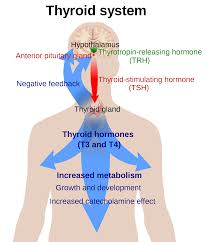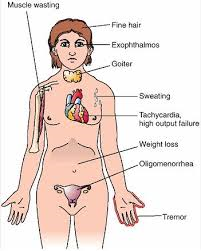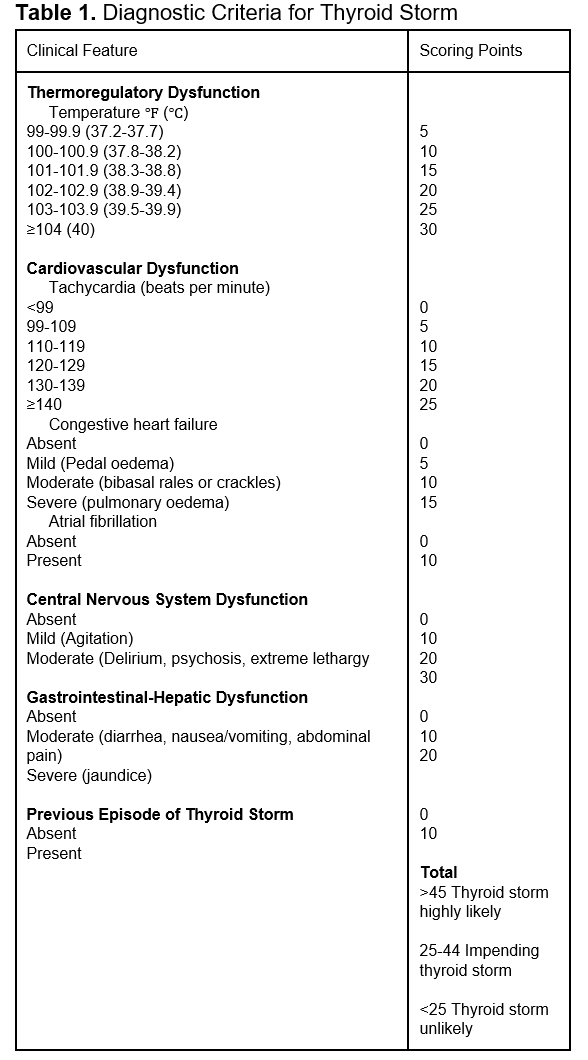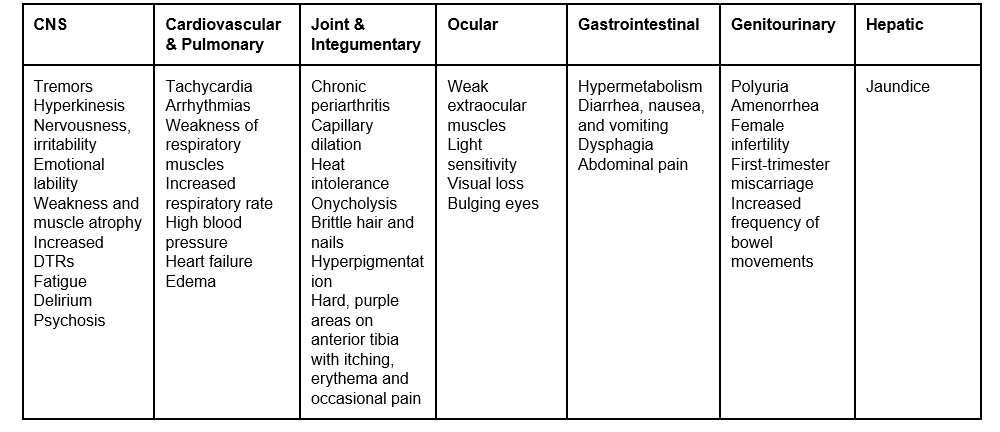Thyroid Storm (Thyroid Crisis)
Original Editors - Chelsea Reed & Tory Schwartz from Bellarmine University's Pathophysiology of Complex Patient Problems project.
Top Contributors - Chelsea Reed, Elaine Lonnemann, Lucinda hampton, Kim Jackson, WikiSysop and Adam Vallely Farrell
Definition/Description[edit | edit source]
An acute, life-threatening exacerbation of thyrotoxiosis. This condition is rare now due to more efficient diagnosis and treatment of thyrotoxicosis in addition to improved management pre and post surgery. When it does occur, it is following illness, trauma, surgery or other major physiological stress in an individual with existing thyrotoxicity. Thyroid storm occurs most commonly in those with uncontrolled or undiagnosed thyrotoxicity with an added precipitating factor. Individuals with a history of hyperthyroidism, Graves' disease, toxic multinodular goiter, adenoma or any other cause of endogenous thyrotoxicity are at the highest risk for experiencing a thyroid storm[1][2][3].
Prevalence[edit | edit source]
Rare, but high mortality rates at 10-20%.1 Currently, incidence may be as low as 0.2 cases/100,000 population. 5 More common in women than men (10:1)[4].
Characteristics/Clinical Presentation[edit | edit source]
Classic presentation characterized by signs and Carroll including:[5]
- Severe tachycardia
- Elevated blood pressure
- Heart failure
- Peripheral edema
- Pulmonary edema
- Chest pain
- Hyperthermia (up to 105.3℉ or 40.7℃)
- Restlessness
- Agitation
- Delirium or psychosis
- Jaundice
- Abdominal pain
- Nausea and vomiting
- Diarrhea
- Profuse sweating
- Dehydration
- Tremor
- Coma
Central Features:
- Thyrotoxicosis
- Abnormal CNS function
- Fever
- Tachycardia (above 130bpm)
- GI tract symptoms
- Evidence of impending or present CHF
Elderly patients can have an atypical presentation characterized by: [5]
- Apathy
- Stupor
- Weakness
- Cardiac failure
- Coma
- Minimal signs of thyrotoxicity
- Absent or low fever
Musculoskeletal Manifestations:
See hyperthyroidism
Associated Co-morbidities[edit | edit source]
- Hyperthyroidism
- Congestive heart failure
- Coronary artery disease
- Sjogren’s syndrome
- Rheumatoid arthritis
- Psoriatic arthritis
- Chronic periarthritis
- Myasthenia gravis
Medications[edit | edit source]
Thionamide: blocks the production/release of the thyroid hormone, as well as the conversion of T4-T3.
Types:
- Propylthiouracil (PTU)
- Methimazole(MMI)
Iodine: blocks the conversion of T4-T3.
Types:
- Saturated solution potassium iodine (SSKI)
- Lugol’s Solution
IMPORTANT: This MUST only be given 1 hour after PTU has been administered. Iodine is a substrate in the production of the thyroid hormone and could make the situation worse if given before the production has been stopped with the use of PTU.
Beta Blocker: blocks the sympathetics peripherally
Types:
- Propanolol
- Esmolol
Steroids: block the peripheral conversion of T4 to T3 and in addition boosts the hypothalamic pituitary access.
Types:
- Hydrocortisone
- Decadron
Diagnostic Tests/Lab Tests/Lab Values[edit | edit source]
Any signs of end organ dysfunction may be seen. Burch and Wartofsky suggested a scoring system to illustrate common features that can be seen when thyrotoxicosis has progressed enough to be considered a thyroid storm (Table 1). [5]
IF lab tests are performed TSH values with be low to undetectable and T4 will be high.
Etiology/Causes[edit | edit source]
Thyrotoxicity occurs when there are abnormally high levels of thyroid hormone circulating within the body, most often due to overactivity of the thyroid gland. Graves’ disease is the most common form of thyrotoxicosis that leads to a thyroid storm. Other causes include multinodular goiter and toxic adenoma. The full pathophysiology of thyroid storm is unknown, but the exposure of increased numbers of beta1-adrenergic receptors to heightened catecholamine levels during times of stress is thought to play a role. Another cause is thought to be involved with the displacement of free thyroid hormones by inhibiting cytokines during illness.[5]
Precipitating Factors: [2] [3] [4]
- Trauma
- Infection
- Surgery
- Emotional/Physiological Stress
- Diabetic Ketoacidosis
- Pregnancy
- Pulmonary Embolism
- Myocardial Infarction
- Pneumonia
- Upper respiratory tract infection
- Enteric infections
Systemic Involvement[edit | edit source]
Systemic Manifestations of Hyperthyroidism[5]
Medical Management (current best evidence)[edit | edit source]
Three main goals for medicinal treatment of a Thyroid Storm:
- Blocking the production and release of the thyroid hormone
- Blocking the sympathetic flow
- Blocking the conversion of T4 to T3
Medication that satisfy these goals include:
- Thionamides
- Iodines
- Beta Blockers
- Steroids
Supportive Care management
- Hyperkinesis- Benzodiazepine
- Hyperthermia- Cooling blankets
- Dehydration- IVF, electrolytes
- Fever- tylenol
Address the precipitating stressor
Physical Therapy Management (current best evidence)[edit | edit source]
Requires immediate medical attention
When medical attention is required?
In a patient experiences the following, especially those with a history of Hyperthyroidism or Graves’ Disease:
- Tachycardia
- Palpitations
- Hyperthermia
- Excessive sweating
- Abdominal pain
- Nausea and vomiting
- Altered consciousness
What should be monitored during treatment session?
Vital signs including: blood pressure, heart rate, and respiratory rate.
Other signs: excessive sweating, shortness of breath, abnormal tenderness with palpation of the thyroid gland, abnormal heart sounds, fever, tremor, and any of the clinical signs listed above.
Hyperthyroidism and Exercise (see hyperthyroidism)
Differential Diagnosis[edit | edit source]
Diagnosis of thyroid storm is made based on clinical assessment as it is a medical emergency and treatment can not wait until lab results are provided. The diagnostic criteria discussed in Table 1 above are used to help guide the clinician in diagnosis. Other conditions to differentiate between for thyroid storm include:
- Hyperthyroidism
- Graves Disease
- Atrial Fibrillation
- Hypoglycemic Attack
- Sepsis
- CVA
- Sympathomimetic toxicity
Case Reports/ Case Studies[edit | edit source]
1. Intraoperative Thyroid Storm: A Case Report
http://eds.a.ebscohost.com/ehost/pdfviewer/pdfviewer?sid=be2eb971-e9c0-47be-8fa3-2d63ac084f75%40sessionmgr4005&vid=12&hid=4210
Case report of an 18 year old female who was 1 year post diagnosis of Graves’ Disease and was underwent elective thyroidectomy surgery. 30 minutes into the surgery the patient’s heart rate and temperature started to rise. Treatment was performed to combat the thyroid crisis and the surgery to remove her thyroid was completed.
2.Thyroid Storm Precipitated by Duodenal Ulcer Perforation
http://eds.a.ebscohost.com/ehost/pdfviewer/pdfviewer?sid=be2eb971-e9c0-47be-8fa3-2d63ac084f75%40sessionmgr4005&vid=12&hid=4210
Thyroid storm triggered by a gastrointestinal perforation in a 55 year old Japanese man. Admitted to the hospital for leg edema and acute severe abdominal pain. On arrival he presented with tachycardia with a goiter, altered consciousness, atrial fibrillation, and swelling of the abdomen.
3. Thyroid Storm during induction of anesthesia http://www.ncbi.nlm.nih.gov/pmc/articles/PMC3506864/
Case report of a 50 year old woman who experienced a thyroid storm during anesthesia induction for a humeral fracture repair. Patient presented with no history of hyperthyroidism nor abnormal signs preoperatively. However, reported weight loss, intermittent palpitations, and hand tremors for the past year.
Resources[edit | edit source]
http://thyroidmanager.org
http://endocrinediseases.org/
http://www.thyroid.org/
https://www.nahypothyroidism.org/
References[edit | edit source]
- ↑ Chiha M., Samarasinghe S., Kabaker A.Thyroid Storm: An Updated Review.fckLRJournal of Intensive Care Medicine.fckLR 2015; 30(3)131-140. http://jic.sagepub.com/content/30/3/131.full.pdf+html
- ↑ De Groot LJ, Bartalena L. Thyroid Storm. Endotext [Internet]. South Dartmouth: MDText.com, 2000. http://www.ncbi.nlm.nih.gov/books/NBK278927/
- ↑ Bartalena L, Hennemann G. Graves’ Disease: Complications. Endotext [Internet].fckLR South Dartmouth: MDText.com, 2000. http://www.ncbi.nlm.nih.gov/books/NBK285551/
- ↑ Pickens A. (2014, April 28). Thyroid Storm. Retrieved fromfckLRhttps://m.youtube.com/watch?v=LWOByFjjemc
- ↑ 5.0 5.1 5.2 5.3 5.4 Carroll R, Matfin G. Endocrine and metabolic emergencies: thyroid storm. Therapeutic advances in endocrinology and metabolism. 2010 Aug;1(3):139-45.










